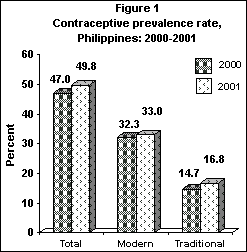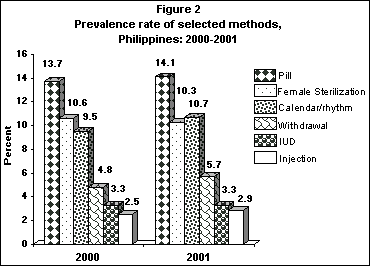Contraceptive Prevalence Rate remains at 49 percent
The contraceptive prevalence rate (CPR) or the proportion of married women 15-49 years reporting current use of contraceptives is up by 2.8 percentage points, from 47.0 percent in 2000 to 49.8 percent in 2001. This significant increase is primarily caused by the increase in the prevalence rate for traditional methods (14.7% to 16.8%), particularly calendar rhythm (9.5% to 10.7%) and withdrawal (4.8% to 5.7%). The use of modern methods also increased, although insignificantly, from 32.3 percent to 33.0 percent. These findings are based from the preliminary results of the 2001 Family Planning Survey (FPS) conducted by the National Statistics Office with funding assistance from the United States Agency for International Development (USAID).

The pill remains as the most popular contraceptive method among currently married women with 14.1 percent using this method. Calendar/rhythm (10.7%) ranks second and female sterilization (10.3%), which ranked second in 2000, drops to third this year. Withdrawal method (5.7%) is the fourth most widely used method, followed by IUD (3.3%) and injection (2.9%).

The 2001 FPS is the sixth in a series of annual family planning surveys conducted nationwide by NSO. A total of 30,122 women 15 to 49 years of age were interviewed for the survey.
